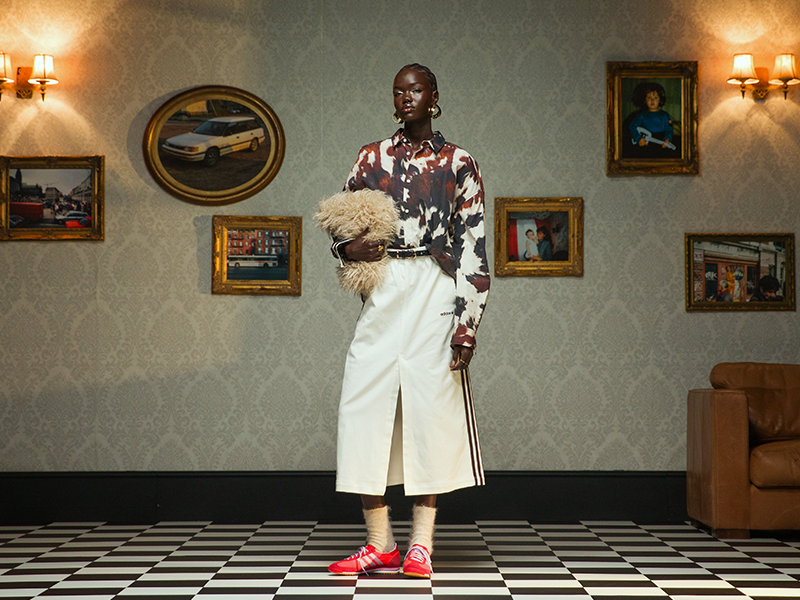Interview: How Asos is building the ultimate brand portfolio to stay ahead in fashion
Asos Brand Director Shazmeen Malik reveals how the online fashion giant is expanding its brand roster, forging powerful partnerships, and using data-led insights to anticipate the next big trends.

Asos is collecting brands like infinity stones. This year alone, the online fashion giant has added 60 new names to its ever-expanding roster pushing the total past 800 and counting.
It already carries the brands you know and love — think Nike, Motel, All Saints and Topshop — but that doesn’t mean it’s slowing down anytime soon.
At the heart of Asos’ recovery strategy is this fresh approach to brands — blending heritage names with buzzy newcomers to deliver the relevance today’s shoppers are hungry for.
In recent months, the retailer has welcomed premium favourites like Arket, For Love & Lemons, Ralph Lauren and Free People, alongside high street staples such as Abercrombie & Fitch and Mango.
But the line-up isn’t just household names. Asos has also onboarded rising indie labels including cult Spanish accessories brand Bimba y Lola, social media–favourite Jimmy Fairly, sustainable activewear brand Tala, and Australian favourites Princess Polly and Kat the Label.
This week, it added British partywear brand Oh Polly, its activewear sister Bo+Tee, and Pharrell Williams’ streetwear brand Ice Cream.
Coming soon are House of CB, True Religion, Khloé Kardashian’s Good American, and Frankie’s Bikinis — including its “head turning” collection made with supermodel Bella Hadid.
Retail Gazette caught up with brand director Shazmeen Malik to find out how Asos is luring top names, responding to changing consumer tastes, and building the ultimate brand portfolio.
Asos’ brand playbook

Over the years, Asos has refined its extensive brand portfolio to reflect changing consumer tastes and fashion trends.
“We’ve been really thoughtful about bringing in both well-known and emerging brands,” shares Malik.
“The goal has always been to offer something for everyone—whether it’s through our own-label offerings or by partnering with third-party brands that are leading trends globally.”
Malik highlights that the mix of established and emerging labels allows Asos to cater to a broad spectrum of customers, from those seeking high-end luxury fashion to those after more affordable styles.
“Some customers are drawn to the premium labels like Ralph Lauren, while others appreciate the more niche brands like Tala, which gives us the flexibility to meet different customer demands. We’re focused on offering a broad spectrum,” says Malik.
“These new brands reflect the variety of what we aim to offer,” she says, emphasising that they’re constantly working to ensure that Asos remains a key destination for fashion-forward customers across a variety of price points.
“The intention of adding new brands is to engage our existing customers better, acquire new customers, and give them something that wasn’t there before,” Malik shares. “So, we’re optimistic about the growth we expect from these brands.”

Fostering strong partnerships with key brands
Strong partnerships with both established and emerging brands have been key to Asos’s strategy — not just in what it sells, but in how it sells it.
Rather than offering a one-size-fits-all platform, Asos tailors its approach to each brand.
Ranges are shot in-house, styled alongside both own-brand and branded collections, and thoughtfully curated by its buying teams to ensure they resonate with the Asos audience.
Malik says this is “where the magic happens”, but it’s a result of careful coordination behind the scenes — blending creative direction, styling, and strategic product placement to make each collection shine.
“We don’t want to just be a transactional platform,” Malik explains. “We want to create a sense of discovery.”
That sense of discovery extends to how Asos positions brands across the site, uses editorial content to bring collections to life, and leverages its growing retail media offering to help partners reach and engage new customers.
“It’s a win-win,” says Malik. “Brands get more visibility, and we get to offer our customers a broader mix that aligns with their tastes.”
Balancing brand and own-brand to stay relevant
Roughly 60% of Asos’s sales now come from third-party brands — a stat that speaks volumes about their importance to the business.
And while many retailers focus on either own-label or branded stock, Asos has long relied on a blend of both to create what it sees as a “more authentic styling destination”.
“Nobody wears head to toe, one brand anymore,” Malik says. “That’s the beauty of Asos. Customers can mix our own-label styles with Nike, Free People or Mango — whatever fits their individual look.”
This hybrid approach allows Asos to remain relevant as shopper preferences shift. Customers get access to global powerhouses and indie labels alike, and the retailer can stay agile with trends.
Recent collaborations have also underscored the strategy.
In December, Asos dropped an exclusive Adidas Design collection that was designed in just three weeks through its agile Test & React model. The collection tapped into Gen Z style codes with oversized silhouettes and mix-and-match separates.

Anticipating trends
In the ever-evolving world of fashion, predicting the next big thing isn’t just a matter of keeping up—it’s about staying ahead of the curve. For Asos, understanding and shaping consumer desires is at the heart of its strategy, allowing the retailer to not only track trends but actively influence them.
Malik shares how the company uses a mix of data, creativity, and speed to stay one step ahead of what shoppers want, ensuring they’re always able to offer the right products at the right time.
“We’re constantly tracking customer behaviour, looking at what they’re buying, adding to their carts, and how they’re interacting with products on the platform,” says Malik. “This allows us to make data-driven decisions that ensure we’re offering the right products at the right time.”
Asos’ data-driven approach allows the retailer to swiftly respond at scale to emerging trends, ensuring that it always has the latest fashion-forward options available for customers.
“It’s not just about reacting quickly, but also making sure we’re in tune with our customers’ needs, desires, and moods,” explains Malik.
“Our strategy isn’t only about responding to what’s trending, but leading the conversation, giving customers what they didn’t even know they wanted yet.”
In addition to the ability to react quickly to trends, Asos is also refining its own brand strategies to create highly relevant, exclusive products.
For instance, Malik shares that a large portion of Asos’ growth comes from its own-label products and its Test & React model. “Our own-label collections have become a way for us to take that data and craft items that speak directly to the current needs of our audience,” she says.
Streetwear strategy: Capturing a key growth area
Streetwear is a major focus for Asos, particularly in menswear, and one the retailer is investing in for the long term.
“We’ve really doubled down on the streetwear trend. It’s a trend th at has been around, but it’s also not going anywhere,” Malik says.
at has been around, but it’s also not going anywhere,” Malik says.
To strengthen its position, Asos has onboarded a number of new streetwear brands — a segment Malik admits wasn’t fully maximised previously.
Standout additions include German streetwear label Prohibited, which Asos is bringing to a global audience as its first major stockist, and Pharrell Williams–founded Ice Cream.
“We launched Prohibited and Alma de Ace Faded Store recently. Some of these brands have no other stock right now, so we’re the first to market and opening up the world to them,” Malik explains.
Asos is now focused on building long-term credibility in the segment through exclusive collaborations and strategic partnerships.
“I think by June or July, we’re going to feel like we’ve really earned a lot of credibility and trust in that segment with the brand portfolio we’ve got,” Malik concludes.
The future of Asos’ brand strategy
Looking to the future, Asos will keep expanding its brand portfolio and refining its offerings to stay aligned with customer demands.
“We’re always looking for new ways to serve our customers, whether it’s through improving our platform’s user experience or adding new brands that reflect the evolving tastes of our audience,” says Malik.
“We’re in a unique position to stay ahead of the curve, and we’re excited about what the future holds.”
Asos’ ability to remain agile is central to its future growth and its new data-driven approach is helping it stay ahead of trends, bringing new products to market faster than ever before.
It is evident the retailer’s brand strategy isn’t just about adding more labels to its platform — it’s about keeping pace with how customers shop and what they’re looking for right now.
By blending big names with up-and-coming talent, reacting quickly to trends, and working closely with partners, the retailer is building a brand mix that feels relevant and future-focused.
In an ultra-competitive market, that focus on flexibility, choice and collaboration could be what keeps Asos one step ahead as it steams on with its turnaround plan.
Click here to sign up to Retail Gazette‘s free daily email newsletter










































































































































































